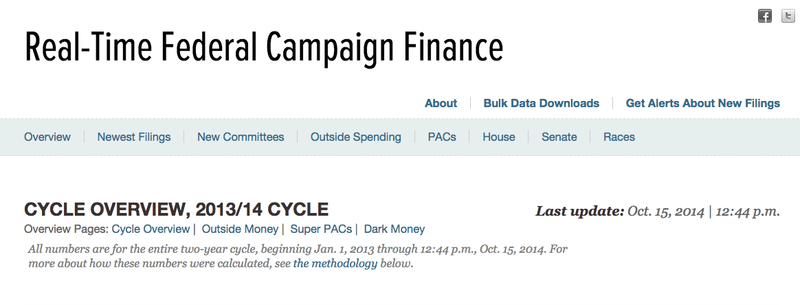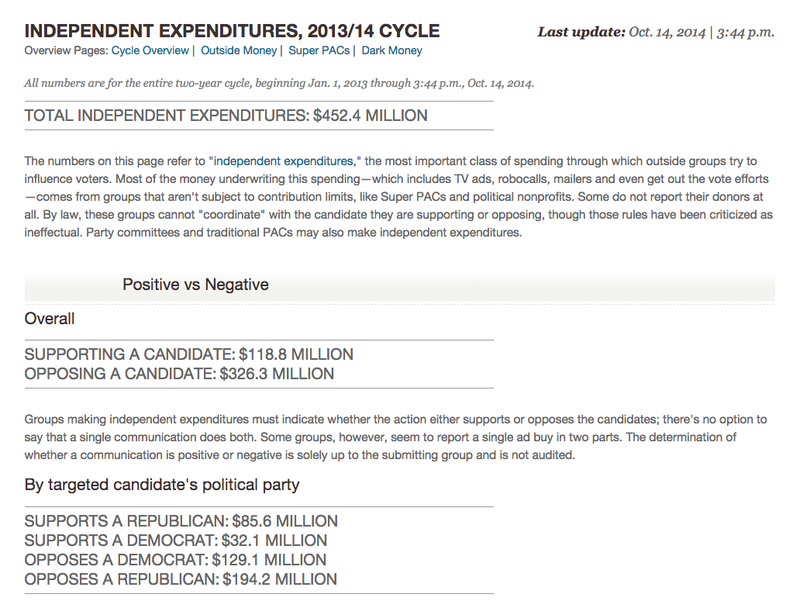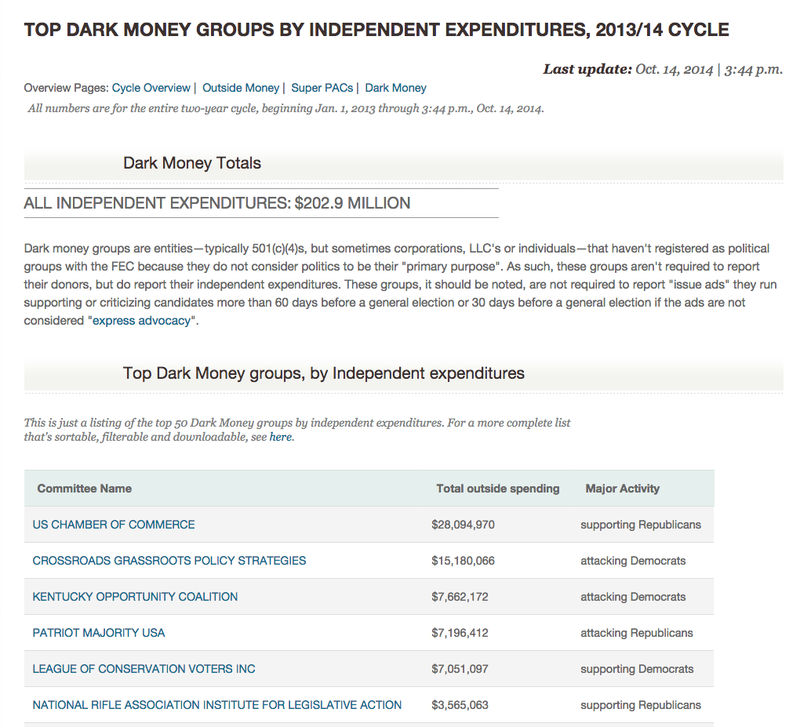Outside spending nears $500 million in Election 2014; Sunlight’s new overview pages break it down

Less than three weeks before Election Day, spending reported to the Federal Election Commission by outside groups trying to influence the outcome of campaign 2014 is approaching $500 million. That’s on top of what candidates themselves are pumping into their races.
Sunlight’s Real-Time Federal Campaign Finance tracker allows you to slice and dice campaign money the moment it’s reported. It also provides data in bulk downloads for users who want to run deeper analyses. Find which individuals and special interests are investing in the election for your home district, or which companies are padding a politician’s campaign war chest.
Taking advantage of our Real-Time tracker’s up-to-the-minute aggregation powers, we’re today launching new overview pages to make it easier to track the ebbing and flowing (mostly flowing) of campaign money in the homestretch of the campaign.
The breakdown of fundraising and spending so far this year is revealing, and perhaps surprising. Among other things, it shows that traditional players are the biggest drivers of the money machine this year. These include committees affiliated with the Democratic and Republican parties — which have combined to raise more than $1 billion and have spent over $841 million in this election cycle alone — as well as “non connected PACs,” so called because they aren’t attached to any political party or campaign. These political action committees can be affiliated with corporations, unions or special interest groups, and have spent more than $1 billion trying to influence 2014 elections — more than twice as much money as the newer super PACs.
But the big super PACs are big players indeed. Born of the Supreme Court’s 2010 Citizens United decision, they can raise and spend money in unlimited amounts to affect elections. One of our new overview pages takes a look at their role in greater detail, categorizing their spending by political preference. This is an editorial judgment that we make here at Sunlight based on committees’ spending patterns.
Super PACs represent one form of “outside spending,” a term that Sunlight (and the Federal Election Commission) use to define spending that does not come from the candidates’ campaign committees. An expense from a political committee that supports or opposes a federal candidate is called an independent expenditure in FEC-talk. These pay for things like attack ads, robocalls and even door-to-door canvassing.
We’ve included an overview page that breaks down all outside spending by tone (positive or negative), by type of committee, by race and by party preference. Visit Outside Money to see independent expenditures summarized on the party of the targeted candidate, whether the seat is for the House or Senate and if the money went toward supporting or attacking the candidate in question.

Another closely watched category of outside spending is “dark money,” a term that Sunlight Editorial Director Bill Allison coined to describe campaign contributions that can’t be traced back to donors. That’s because they flow through 501(c) organizations that under tax law don’t have to disclose sources of their funding. Not even all of their expenditures have to be reported, but those made at this time of year — in the final weeks before an election — do show up at the FEC. You can find them here.
That figure is driven by a small clutch of powerful groups, which in turn are fueled by a handful of wealthy donors. The top super PACs page lists the top 50 of these committees by their reported IE’s.
The biggest players are familiar names to anyone following the campaign beat: From the Senate Majority PAC, founded by former staffers to Sen. Harry Reid, D-Nev., to the conservative Ending Spending Action Fund, bankrolled by TD Ameritrade Founder Joe Ricketts, you can find each committee’s total spending, its major activity (i.e. “supporting Democrats”) and the date of its most recent filing with the FEC on the super PACs overview page.
However, in recent cycles, we’ve witnessed an increasingly large share of campaign advocacy coming from groups that don’t file regular reports with the Federal Election Commission — dark money operations that don’t disclose their donors. Like super PACs they can make independent expenditures advocating for or against a candidate but are not supposed to be primarily focused on politics.
Non-committee filers, whether they are 501(c)4 social welfare groups, trade associations or LLC’s also report their independent expenditures. On the Dark Money page you can see the total reported spending by each of the top 50 players as well as their major activity.

Both pages have summary stats on the total spent by either type.

